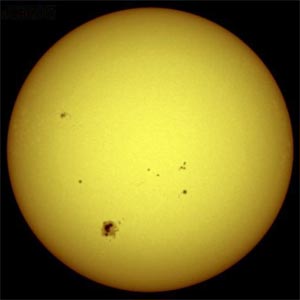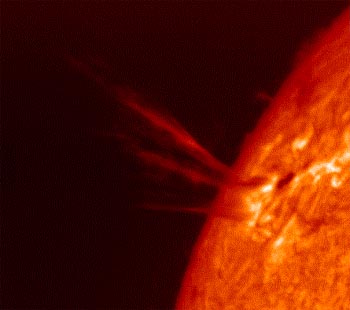pop up description layer
HOME
Cryptozoology UFO Mysteries Aviation Space & Time Dinosaurs Geology Archaeology Exploration 7 Wonders Surprising Science Troubled History Library Laboratory Attic Theater Store Index/Site Map Cyclorama
Search the Site: |
|
The sun is the heart of the solar system and almost all life on earth gets its energy from the radiation coming from its 10,000 degree surface. We often think of the sun as a part of our solar system, but it might be more correct to think of it as the solar system. Almost 99.86% of the mass of the solar system is tied up in the sun. All the rest of the solar system - the rocky planets: Mercury, Venus, Earth and Mars; the gas giants: Jupiter, Saturn, Neptune and Uranus; the asteroids and dwarf planets like Pluto - only add up to the measly remaining 0.14 %. So the sun is huge. In fact, its diameter is 863,706 miles (1,390,000 km): large enough to fit 1.3 million earths inside of it. Because the sun is so large, it has an enormously strong gravity field. This huge mass, 2,000,000,000,000,000,000,000,000,000,000 kg, is 300,000 times the mass of Earth. The gravity this mass generates keeps all the other members of the solar system orbiting around the sun. In addition, the gravity field also causes huge pressures deep in the sun's core. This huge pressure (equivalent to 250 billion Earth atmospheres) and high temperatures it generates in the core (16 million degrees) causes the sun to release energy through nuclear fusion.
Nuclear Fusion The type of nuclear fusion that occurs in the sun is the result of the nuclei of two hydrogen atoms being forced together. On Earth this never happens because all hydrogen nuclei are positively charged and repel each other. In the center of the sun under these extreme pressures and temperatures, however, two hydrogen nuclei can fuse together to become a single helium nuclei. In this process, some of the mass of the original hydrogen is converted to energy. It is this energy that powers the sun. Every second inside the sun 700 million tons of hydrogen is converted to about 695 million tons of helium. At this rate you might think that all the hydrogen in the sun would quickly be used up, but actually scientists estimate that the sun will be able to fuse hydrogen for at least another 5 billion years without trouble. At its current age of 4.5 billion years the sun has reached the point where about 70% of its mass is hydrogen and 28% helium. The energy from fusion in the core of the sun slowly makes its way to the surface in a journey that takes between 10,000 and 170,000 years as the photons carrying the energy are emitted, reabsorbed and re-emitted again. Eventually it reaches the surface of the sun which is called the photosphere. Below the photosphere the sun is opaque to visible light. Above the photosphere is the sun's atmosphere which is transparent. Rotation and Sunspots Because the surface of the sun is gaseous, the sun rotates at different speeds at different latitudes. Near the poles it takes about 33.5 days to go around, while near the equator it rotates every 25.6 days.
One of the first ways that astronomers came to the conclusion that the sun rotated at all was by observing sunspots. Sunspots are places on the surface of the sun where intense magnetic fields have developed slowing convection (the transfer of heat) from the interior of the sun to the surface. Because of this sunspots are comparably cooler and darker than the rest of the sun's surface. The Chinese astronomer Gan De observed sunspots as early as 364 BC. In the 17th century Galileo Galilei showed that sunspots were not the shadow of the passage of the planet Mercury in front of the sun (as some other astronomers had thought) but were actually marks on the surface of the sun that moved as the sun rotated. He also observed that they changed, disappeared, and reappeared over time. This observation that the sun was not perfect challenged the thinking of the Greek philosopher Aristotle (who taught that all celestial bodies were perfect, unchanging spheres) and helped lend support to the heliocentric (the planets circle the sun) explanation of the solar system. This, in turn, got Galileo in much trouble with the authorities at the Catholic church. The surface of most of the sun is about 10,000 degrees Fahrenheit (5,500 degrees C). However, sunspots can be as cool as 7,300 degrees Fahrenheit (4,000 degrees C). Cool is a relative term here, though. Steel melts at 2,500 Fahrenheit (1,370°C). Sun's Atmosphere The part of the sun's atmosphere just above the surface is known as the chromosphere. It's slightly cooler than the surface and is invisible during normal conditions. However, during a solar eclipse, when the moon blocks out the bright photosphere, the chromosphere can be seen as a red ring around the edge of the dark moon. The upper part of the sun's atmosphere is the corona. It is much hotter than either the chromosphere or the photosphere with temperatures as high as 3.5 million degrees Fahrenheit (2 million degrees C). Scientists don't exactly know why the corona is so hot, but they suspect it has something to do with the sun's tremendous magnetic field which is always turning and twisting. The magnetic field can throw huge plumes (called solar flares) of material from the sun into space. Some of the material that gets ejected out of the corona becomes the solar wind. When the sun goes through a particularly violent set of magnetic field changes, it can create a surge in the solar wind that causes a geomagnetic storm on Earth. Such a storm can cause spectacular auroras in the northern and southern skies, but can also damage the electronics on satellites and cause disruptions in radio communications. Life Cycle
Although the sun is the most prominent object in Earth's sky, it is just one of the billions of similar stars in our Milky Way galaxy. While it is far from being among the biggest stars, it is brighter than 85% of them. (Most of the stars in our galaxy are relatively dim "red dwarf" stars). Like all stars, the sun has a lifecycle. It is currently about 4.567 billion years old. Though some larger stars end their lives in a gigantic explosion known as a supernova, the sun will suffer a quieter death. When its hydrogen runs low in about 5.4 billion, years it will start fusing helium instead. This will cause the sun to expand into what is known as a giant red star. It will become so big that it will likely engulf Earth's orbit (all life on Earth will probably be extinct at this point, anyway, because a slow increase in the sun's heat output will vaporize the oceans in about a billion years). Eventually the sun will go through a series of expansions and contractions and lose most of its mass in an expanding cloud known as a planetary nebula. The core of what is left will become a white dwarf star which will continue to glow for trillions of years. Copyright 2014 Lee Krystek. All Rights Reserved. |
|
Related Links |
|
|






